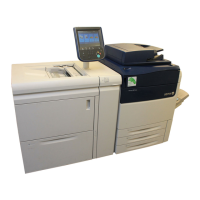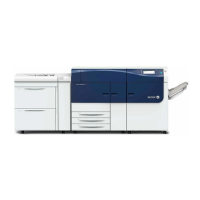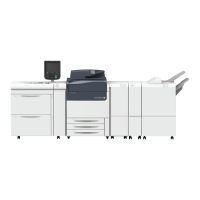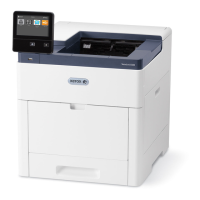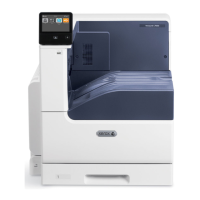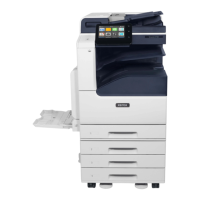This smear occurs primarily with black (K); however, if other image quality problems occur, such as
ghosting, the other colors, Cyan (C), Magenta (M), and Yellow (Y), may also be adjusted to correct
these problems.
Secondary Transfer Voltage Adjustment
The purpose of this adjustment is to correct for mottle (uneven toner coverage) and color shift
(inconsistent color). These image quality issues can occur on heavy-weight stocks. This adjustment
creates and saves an image transfer adjustment to the Bias Transfer Roll in the press. The Bias
Transfer Roll is where the image is transferred from the belt to the paper. Once created for a stock, the
adjustment is saved and can be selected for that stock for any tray.
The adjustment can be performed by selecting either the Auto or Manual buttons.
• Auto button: The adjustment is done automatically by the press and eliminates the need for you
to interpret printed targets and manually enter adjustment values. This saves time and avoids
errors. Usually Auto fixes most image quality issues and should be used before performing a
manual adjustment.
• Manual button: The user must manually perform the adjustment and step-by-step instructions for
printing test patterns, interpreting the printed targets on those patterns, and then manually
entering the adjustment values. Use the Manual adjustment option only when the Auto
adjustment does not provide the desired output.
For more information, refer to Secondary Transfer Voltage Adjustment. Also refer to these procedures:
Using the Auto Adjustment Option for Secondary Transfer Voltage Adjustment and Using the Manual
Adjustment Option for Secondary Transfer Voltage Adjustment.
Transfer Output Adjustment for Trail Edge
This option raises or lowers the transfer voltage timing to the 2nd Bias Transfer Roll, which in turn
reduces trail edge deletions on the output. Select between 0-100%. The default setting is 100%.
Note: This adjustment should not be used for trail edge flip problems which are caused by
heavyweight stock.
Adjustment of Paper Speed at Transfer
Note: This option is used very infrequently.
In the press, the distance between the Second Transfer and Fuser is very small. When feeding large
paper sizes, the paper is nipped (gripped) simultaneously by both the Second Transfer and Fuser.
Occasionally, the paper is pulled between the Second Transfer and Fuser, which can cause paper
damage or image defect on the output. When this happens, this option allows you to make very small
adjustments in order to successfully feed paper through the Second Transfer and Fuser areas without
damage or defects.
The adjustment amounts range from -0.50% to a maximum of 0.50%. The default is 0 (zero).
Fuser Temperature Adjustment
This option allows the user to adjust the fuser temperature for specific media types. Under most
conditions, the press adjusts the fuser temperature automatically at point of need. However, on
infrequent occasions the user can minimally adjust the fuser temperature for specific stock weights or
a specific job flow.
For Example
The printed output shows signs of offset or flaking dry ink/toner. This can be caused by specific media
Xerox
®
Versant
®
4100 Press
User Documentation
123
Working With

